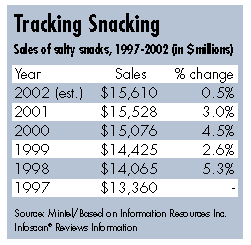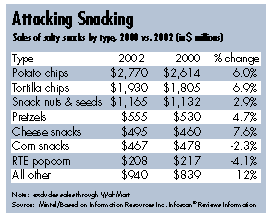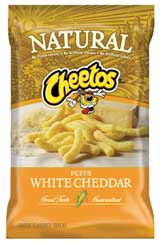
With more than a 41% market share and topping every salty snack segment except snack nuts and seeds, Frito-Lay (Plano, Texas) dominates the salty snacks category. For a comparison, consider that the next-largest salty snack presence is private label items, accounting for 6% of the category total. This explains the abundance of regional brands strong in many segments. Mintel notes that the number-two brand is highly dependent on region, although a few other national companies challenge Frito-Lay in some segments.
Extensions in salty snacks can run the gamut between new flavors, innovative shapes and novel containers. Changing consumer tastes have had a direct influence on product innovations for snack foods, resulting in a richer variety of spices, herbs and other flavor enhancers, such as roasted garlic. Of course, this also results in a highly segmented market.

Manufacturers also have responded to consumers' hectic lifestyles by introducing more-convenient packaging. Simply put, a snack on the go is a meal substitute for many, and some regard it as the fourth meal. Again, Frito-Lay leads the way here, with its launch of Go Snacks, portable packages of its favorites that can fit into an automobile's cup holder for added convenience. Such single-serve products could lead to a number of changes in the market, notably rising prices.

Children of the Corn
Following the trend toward robust flavors, corn chips have seen a 25% jump in sales, although new forms and colors also boosted the segment. Frito-Lay leads with its Fritos brand, but the company has not been sitting on its hands. The traditional varieties have expanded to include Chili Cheese, Flamin' Hot Texas Grill-style Honey BBQ and Nacho Fiesta, among others. Innovating in shapes also has benefited Fritos, as the Flavor Twists version boasts larger, sturdier chips to ease dipping.Frito-Lay's control of the segment grew to 79% in 2002. The category was helped by the late 1990s' return to flavor among consumers, although baked varieties, such as Baked Bugles, have fared better than some more-healthful products, including low-fat and fat-free varieties.
Tortilla chips account for 23% of the overall salty snack market. Frito-Lay's introduction of Doritos Extremes, Tostitos Scoops and Tostitos Santa Fe Gold led to a spike in sales from 2000 to 2001.
Going to Pot-ato
With 32% of sales in 2002, potato chips are the runaway leader among salty snack segments. Powerhouse Frito-Lay drove potato chip sales with such introductions as Lay's Bistro Gourmet and new varieties of Wavy Lay's, although Procter & Gamble's (Cincinnati) Pringles line boosted the segment as well.According to Mintel's exclusive consumer research, 88% of households consume potato chips, a full 6% ahead of popcorn and 9% in front of corn/tortilla chips. Furthermore, households that consume potato chips eat plenty of them, with nearly three-quarters of them saying they had consumed two or more bags within the past 30 days.
Of potato chip-consuming households, 50% of those with children report consuming three or more bags in the past month, while 85% of the potato chip eaters prefer regular potato chips. Despite the abundance of new flavor introductions over the last several years, plain garnered the most consumer dollars, with barbecue and sour cream & onion tied for second, enjoyed by 54% of households where potato chips are eaten. Although plain chips were purchased by 81% of households, manufacturers continue to launch potato chips featuring exotic and sophisticated flavors, notes Mintel.
While consumers may enjoy their potato chip, few have a tangible brand allegiance, for only 22% of the group eat only one brand. A mere 2% opt just for the store brand, so 78% of potato chip consumers vary their brand purchases, based on taste, price or other factors.

A Flavor Twist
Among respondents to Mintel's consumer research, 63% eat pretzels, and the largest percentage of those reported eating one bag within the past 30 days. Some 66% of households headed by 35- to 64-year-olds consume pretzels, making that the largest demographic enjoying the twisted treat. Only 54% of those 65 and older partake, while 57% of 18- to 24-year-olds do.Despite this fairly deep market penetration, pretzels were the only salty snacks segment to show net declines from 1997 to 2002, according to Mintel. Of course, this drop in sales followed a boom in the early 1990s stemming from consumer interest in more-healthful items. Considering pretzels are naturally low in fat—with many varieties containing no fat—health-conscious consumers realized these products were a viable option. However, since that time, there has been a trend to flavor and indulgence, and pretzel sales have suffered. Efforts to curtail those falling sales included Frito-Lay's 2002 launch of Rold Gold Flavor Rush pretzels, manufactured with an intense flavoring technique.
Close behind segment-leading Rold Gold, Snyder's of Hanover saw its sales rise 8.1% between 2000 and 2002. In fact, Snyder's sales have risen consistently over the last six years, gaining 23% as the whole segment has dropped nearly 7%. The company bucks the trend by focusing on product innovation and a consistent-sales guarantee that retailers will make room for its products.
Nutty Behavior
Riding the wave of positive health news, nuts have experienced 34% sales growth since 1997. Heart-healthful benefits of certain nuts, plus the fact that a number of nuts are considered good sources of monounsaturated/”good” fat, have prompted some consumers to add them as snacks to their diets, and this has been fueled further by studies associating peanut and other nuts with a lower risk of coronary heart disease.However, the nuts segment has seen sales slow in recent years, though Mintel attributes this to two factors. Private labels own more than a quarter of the segment's sales, and the impact of Wal-Mart and warehouse clubs has lowered the average price of items, while raising volume sales.
Perhaps most unusual about nuts is that it is one of very few segments not headed by Frito-Lay. Leading the way here is Kraft/Nabisco (Glenview, Ill.), which reported 2002 sales in excess of $446 million. Its Planters snack nuts remains the market leader and is the segment's only brand to benefit from national television advertising. In 2002, Kraft/Nabisco accounted for 38% of the snack nuts and seeds segment. Second place went to private label items, with just over a quarter of the total segment in 2002. Mintel believes this is evidence that consumers will remain loyal to a store brand if the item is a commodity.

Popping Rocks
Due no doubt to the abundance of flavorful microwave popcorn varieties, ready-to-eat (RTE) popcorn has suffered a 14% sales drop since 1997. Though 82% of respondents consume popcorn products, RTE versions are the smallest category among salty snacks, accounting for $200 million in sales in 2002. Lower-fat items blossomed briefly when consumers sought more healthful items, but demand for more-flavorful snacks dimmed the RTE segment.RTE popcorn has some potential, considering 48% of households say they consumed three or more bags within the previous 30 days. However, microwave popcorn does not present the same freshness difficulties that plague RTE versions.
None of this has stopped Frito-Lay from also claiming the top spot in this segment. Its Chesters brand popcorn, however, has seen a 47% sales plummet since 1997, while its well-known Cracker Jack fell to $21 million in 2002 from its 1999 peak of $39 million. Lincoln Snacks (Lincoln, Neb.) sought to boost consumer interest through flavor extensions, including pecan, cashew, and almond/pecan varieties.
With the Greatest of Cheese
Enjoying robust growth since 1997, cheese snacks have benefited greatly from the consumers' return to flavor. Bold flavor, in fact, has been a boon to this segment, as products like Bachman Company's Max Jax Hot and Spicy Cheese Curls cater to consumers looking for a little extra taste. Plus, manufacturers of cheese snacks also have innovated with new shapes and colors.Frito-Lay's Chee-tos took the shapely route with a number of introductions, such as X's & O's, Zig Zags, Crunchy Nacho Cheese and Cheesy Checkers.
Households with children are a virtual lock to consume salty snacks, with 99% enjoying the treats. Penetration is nearly as great among households without children, considering the 96% reporting snack food consumption. However, because families generally are having fewer children (and the resulting decline in households with children), Mintel warns that manufacturers may need to adjust their marketing efforts, change the types of products offered, where they are offered and how they are promoted. Nonetheless, Mintel predicts the market for salty snacks will grow 25% from 2002 to 2007.
For more information on the report, “The Salty Snacks Market,” contact Mintel International Group Ltd.; 213 W. Institute Place, Suite 208; Chicago, IL 60610; phone: 312-932-0400.
Website Resources
www.mintel.com— Mintel International Groupwww.howstuffworks.com/question579.htm— Where did the potato chip come from?
www.plainsense.com/Health/Weight/snacking.htm— Snacking for weight control
